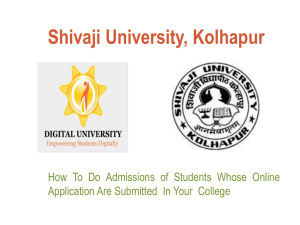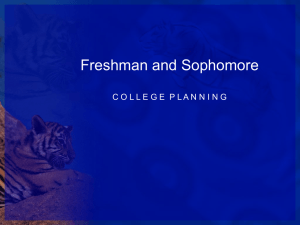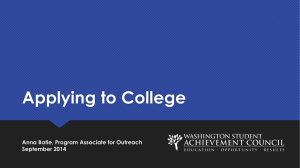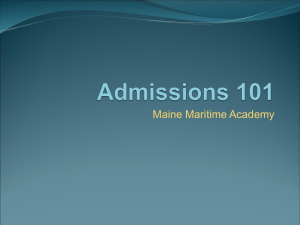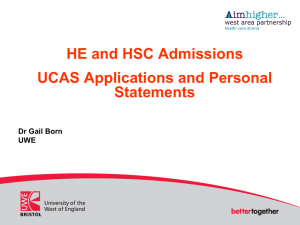Q1. How familiar are you with the concept of a Sports Center being
advertisement
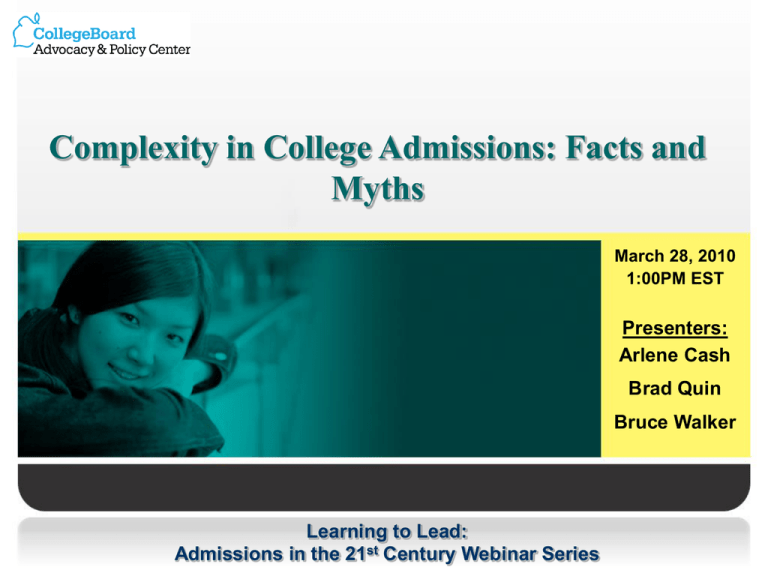
Complexity in College Admissions: Facts and Myths March 28, 2010 1:00PM EST Presenters: Arlene Cash Brad Quin Bruce Walker Learning to Lead: Admissions in the 21st Century Webinar Series Advocacy & Policy Center Mission: To increase the number of students who earn a college degree and who are prepared to succeed in the 21st century. Approach: Areas of Focus College Preparation & Access Arts at the Core The CollegeKeys Compact™ School Counselor Advocacy Teacher Advocacy Minority Male Achievement Undocumented Students and the DREAM Act The National Commission on Writing College Affordability & Financial Aid – – – – – Cracking the Student Aid Code Rethinking Student Aid Trends in Higher Education Education Pays Simplifying State Aid Processes College Admission & Completion – – – – College Completion Agenda Admissions in the 21st Century Access & Diversity Collaborative Community College Transfer & Retention Study Overview Objective: Explore the topic of complexity in the admission process through research based on student and parent perceptions Measure student and parent perceptions of complexity Differentiate responses by income, race and ethnicity, first generation status and geography Identify which subgroups find the process (or aspects of it) complex and why Identify possible responses to key findings Survey Overview: 600 students planning to enroll in a 4-year college 300 parents of students planning to enroll in a 4-year college A Closer Look: Fact or Urban Myth? Examined 7 Areas from the Student & Parent View: Getting Information about College Application Process: General Application Process: Schools to which students applied Application Process: Features of the application process Application Process: By school type & size Sources of Help During the College Application Process Overall Perceptions of the College Application Process Parents Experiences with the College Application Process Demographics Getting Information about Colleges Learning to Lead: Admissions in the 21st Century Webinar Series Application Process: General Learning to Lead: Admissions in the 21st Century Webinar Series Respondents’ Suggestions for Making the Process Less Confusing/Complex Top Four Suggestions: Students Top Four Suggestions: Parents Better instructions/Step-by-step guides/Clear checklist: 15% Improve college websites/Make websites more user- friendly/ Better information on websites: 14% Use a common application/Have everything in one place or on one website: 10% Better communication between colleges and students, parents, high school staff/Better or more timely notification when items are missing: 9% Better communication between colleges and students, parents, high school staff/Better or more timely notification when items are missing: 11% Improve college websites/Make websites more user- friendly/ Better information on websites: 10% Better instructions/Step-by-step guides/Clear checklist: 9% Use a common application/Have everything in one place or on one website: 7% Application Process: Schools to Which Students Applied Learning to Lead: Admissions in the 21st Century Webinar Series Application Process: Features of the Application Process Learning to Lead: Admissions in the 21st Century Webinar Series How Confusing Were Specific Features of the Admissions Process? Top Three From a List of Standard Processes; Scale 1 Low, 10 High From a List of “special” processes; Scale 1 Low, 10 High Knowing how admission decisions are made Write an essay Students: 3.32 Parents: 3.64 Being able to find information they needed on a college’s website Students: 2.68 Parents: 2.24 Completing the application form Students: 2.62 Parents: 2.47 Students: 3.50 Parents: 3.14 Apply for admission to a specific college within the school Students: 2.64 Parents: 2.33 Submit samples of high school coursework Students: 2.49 Parents: 2.26 Application Process: By School Type and Size Learning to Lead: Admissions in the 21st Century Webinar Series Does Complexity Vary by School Type or Size? Students: Rating 1 Low, 10 High Parents: Rating 1 Low, 10 High Public: 2.55 Private: 2.51 Small: 2.54 < 4,000 Medium: 2.67 4,000 to 9,999 Large: 2.55 >10,000 Public: 2.26 Private: 2.31 Small: 2.02 < 4,000 Medium: 2.52 4,000 to 9,999 Large: 2.32 >10,000 Does Complexity of Specific Tasks Vary by School Type: Top 5 Public: Rating 1 Low, 10 High Private: Rating 1 Low , 10 High Write an essay: 3.37 Apply for admission to a specific college within the school: 2.51 Submit samples of high school coursework: 2.48 Have an interview with admissions staff: 2.43 Get letters of recommendation:2.07 Write an essay: 3.21 Submit samples of high school coursework: 2.44 Have an interview with admissions staff: 2.41 Get letters of recommendation: 2.31 Apply for admission to a specific college within the school: 2.12 Does Confusion about Features of the Process Vary with School Size: Top 3 Knowing how admission decisions are made Small: 3.47 Medium: 2.63 Large: 2.57 Knowing if all required materials were submitted Small: 3.16 Medium: 2.43 Large: 2.54 Being able to find information they needed on a college’s website Small: 3.21 Medium: 2.59 Large: 2.62 Sources of Help During the College Application Process Learning to Lead: Admissions in the 21st Century Webinar Series Overall Perceptions of the College Application Process Learning to Lead: Admissions in the 21st Century Webinar Series Stressors in the Process: Top 3 Those factors that were not stressful (rated 1-5) Those factors that were stressful (rated 6-10) Was not complicated/All information needed in one place/Process was selfexplanatory: 32% Waiting for the answer was the stressful part/Not knowing if they would be accepted: 15% Different applications have different requirements/Difficult to gather all the required items: 14% Different applications have different requirements/Difficult to gather all the required items: 34% Worried about deadlines/Difficult to meet deadlines: 26% Very time consuming/Hard to balance with work, school, and extracurricular activities: 18% Demographics Learning to Lead: Admissions in the 21st Century Webinar Series Student Demographics Type of high school student attends Students (N=600) Parents (N=300) Students (N=600) Parents (N=300) Public school 88% 86% 2.99 or less 11% 6% Private school 11% 12% 3.00 to 3.24 13% 13% Home school 1% 2% 3.25 to 3.49 12% 10% Students (N=600) Parents (N=300) 3.50 to 3.74 19% 21% 3.75 to 3.99 19% 19% Life sciences 19% 14% 4.00 or greater 18% 14% Physical sciences 17% 17% Don’t know 8% 17% Social sciences 17% 11% Business 16% 14% Students (N=600) Parents (N=300) Medical sciences 11% 13% % taking SAT 98% 97% Liberal arts 10% 9% % taking ACT 48% 61% Education 8% 10% Combined SAT score Communications 4% 6% Students (N=457) Parents (N=138) Undecided 9% 6% Mean SAT score (std. deviation) 1574 (306.50) 1529 (351.09) 1570 1540 Students (N=237) Parents (N=76) Mean ACT score (std. deviation) 24.37 (5.23) 25.08 (5.93) Median 24.00 25.00 Student’s anticipated major field* High school GPA Standardized tests taken Median Combined ACT score General Demographics Students (N=600) Parents (N=300) Less than $20,000 10% 6% $20,000 but less than $40,000 18% 18% $40,000 but less than $75,000 23% 26% $75,000 but less than $150,000 21% 27% $150,000 or more 8% 12% Don’t know 18% 1% Refused 2% 10% Students (N=600) Parents (N=300) Male 42% 32% Female 58% 68% Parent’s Household Income Gender of Respondent Conclusions and Recommendations Learning to Lead: Admissions in the 21st Century Webinar Series Getting Information About College Findings: Parents and students offered college application process classes or seminars found them helpful Recommendation: Work with high schools to develop college information programs Establish guidelines and evaluation to ensure programs are effective Application Process: General Findings: College choice is only moderately complicated; multiple college choices increase complexity College choice is generally made by student, or jointly between student and parent First-generation students report making decision solely Recommendation: Develop materials targeted to first-generation students Develop suggestions to help all students make wise decisions on college type, needs and goals Schools which Students Applied Findings: Students apply to ~ 4 colleges/universities on average Students most frequently apply to public schools and in-state schools First-generation and lower-income students are less like to apply to private/out-of-state schools Recommendation: Investigate the barriers preventing first-generation and lower income students from applying to private/out-of-state schools Features of the Application Process Findings: Applying to college was a fairly simple and clear process for students More difficult when applying to numerous schools Most students complete applications online Knowing how admission decisions are made is most unclear Writing essays and submitting recommendation letters were fairly simple No major barriers identified for students from lowincome families, first-generation or geographical location Features of the Application Process Recommendation: Encourage colleges to be more transparent regarding the admission decision-making process By School Type & Size Finding: Slight differences emerged based on type of size but not significant to provoke change Recommendation: Develop suggestions to help all students make wise decisions on college type, needs and goals Sources of Help Findings: Students rely on parents and high school counselors First-generation and lower income students are less likely to receive help from parents More likely to receive help from school counselors, teachers, friends, and older siblings Recommendation: Encourage colleges to have informative, up-to-date, and easy to navigate websites Assist schools with the development of additional basic information about the college application process Overall Perceptions Findings: Moderately stressful to apply to college Stress is based on outcomes not process Secondary stress: Different applications have different requirements Balance between application process and high school life Parents and students are confident about college choices Overall, respondents felt the application process is easy and self-explanatory Part II: Complexity Report Objective: To understand how much , when and why students – particularly those form disadvantaged backgrounds – fall out of the process or otherwise aim too low in pursing college, given their academic qualifications If complexity in the application process is not a significant factor (see Phase I research findings), what other factors are impacting college attendance outcomes Target Populations Low-Income, low-socioeconomic status, first-generation Release Date Fall 2011 Upcoming Webinars Learning to Lead: Admissions in the 21st Century Webinar Series Cracking the Student Aid Code April 28, 1:00 – 2:00 p.m. EDT Leadership, Access and Institutional Mission May 18, 1:00 – 2:00 p.m. EDT To download Complexity in College Admissions: Fact or Urban Myth and register for the upcoming webinars, visit http://advocacy.collegeboard.org.
